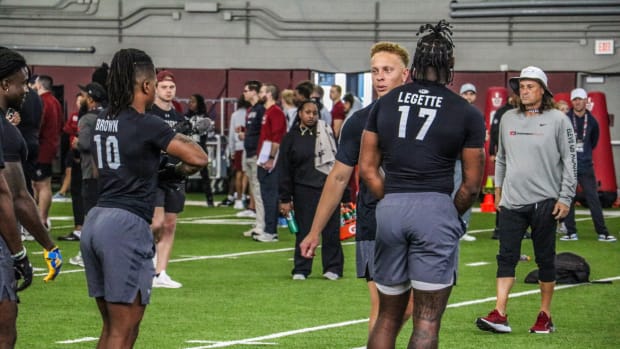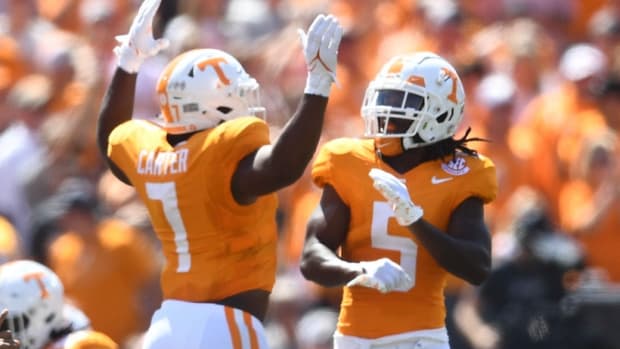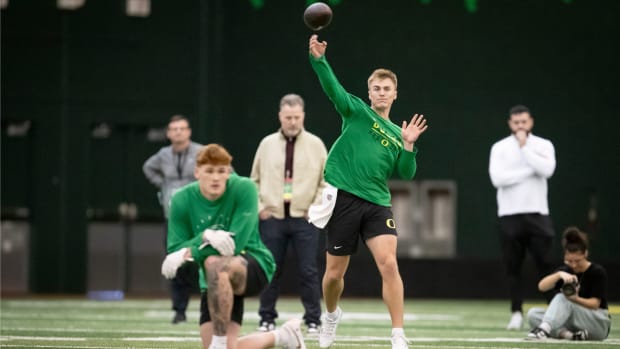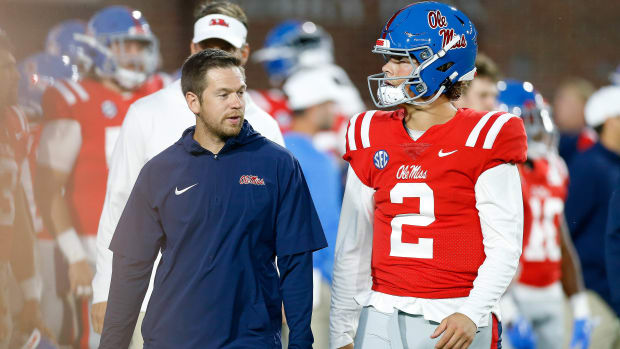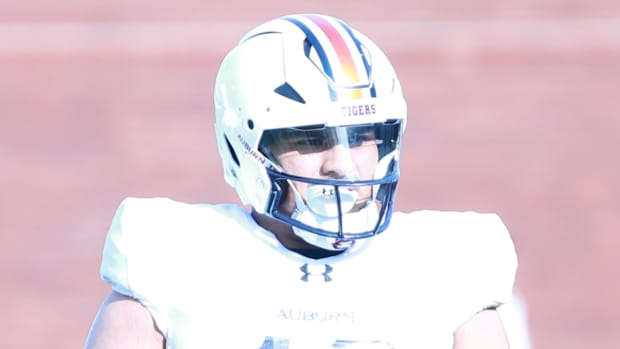On June 3, most of the Missouri football team gathered with coaches and administrators and walked a half mile from campus to the Boone County Courthouse, where they knelt in silence to commemorate the recent killing of George Floyd by Minneapolis police. Afterward, about 60 players entered the building and registered to vote.
Similar athlete demonstrations had played out at U.S. colleges since Floyd’s death a week before, but this one held particular meaning because it was at Missouri, where five years earlier the Tigers had launched a groundbreaking midseason protest. Those players had refused to participate in football-related activities until the university president, who they believed had responded inadequately to a series of racist incidents on campus, was removed.
Now, across the country, football teams were using Missouri’s 2015 playbook to demand change. Within days, players at Texas would refuse to participate in recruiting or fundraising events unless a series of racial justice demands were met. Mississippi State running back Kylin Hill vowed that he’d no longer play for the Bulldogs unless his home state changed its flag, which included the Confederate battle emblem. Similar stances among players at Kansas State and Oklahoma State revealed how the power structure within college sports—if not the entire country—was being challenged by those at ground level.
The scene at the courthouse in Columbia suggested something else: that progress had been made in the past five years at Missouri. University president Mun Choi, who replaced Tim Wolfe after ’15, marched with the players. So did the Tigers’ new coach, Eli Drinkwitz. Unity was the theme, and the widely shared photographs of Mizzou’s diverse roster kneeling outside the courthouse were potent.
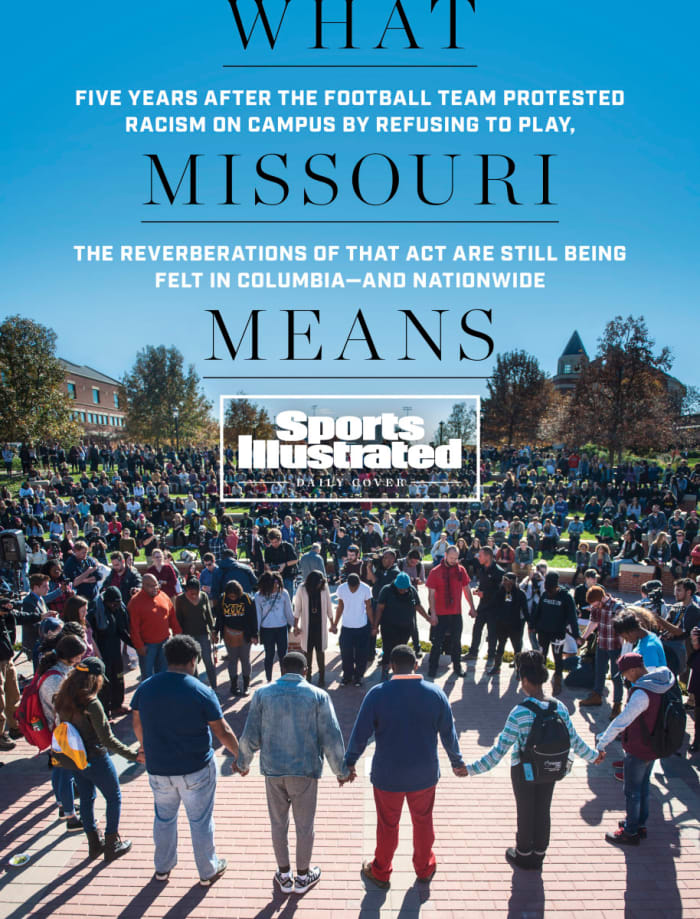
As football players refused to take the field, protesters filled Missouri’s quad in 2015.
Michael Cali/TNS/Zuma Wire
On the campus where the march began, however, a less harmonious story was playing out. Students were still posting on social media with the hashtag #BlackatMizzou, sharing hundreds of personal stories about ongoing racist aggressions. A controversy over the statue of Thomas Jefferson that sits on the quad continued to roil the school, with graffiti and cardboard signs surrounding Jefferson’s bronze likeness, reminding passersby that he enslaved 600 people and raped and impregnated one of them multiple times, beginning when she was a minor.
As the fifth anniversary of the football protest approached, Sports Illustrated spoke with more than 50 Missouri students, athletes, coaches, administrators, faculty and alumni. Each of them professed to love the university, and the vast majority of them believe it still struggles with the same issues, and the same power structures, that moved the ’15 football team to take its stand.
“It’s inaccurate to say that things have gotten better since the protests,” says Peyton Joseph, a four-year soccer starter who graduated this year. “If you go on Twitter and search #BlackatMizzou, there are hundreds and hundreds of experiences of Black students.”
Today, the legacy of the ’15 protests continues to affect nearly every facet of how the university addresses race—and to illustrate the difficulty of making change. Despite the results they achieved, including the establishment of the Division of Diversity, Inclusion and Equity, and despite the protests’ peaceful nature, Choi has made clear that he does not want ’15 to repeat itself. In summertime Zoom meetings with administrators—their contents later shared with the press—Choi advised them to discourage student protests, not because of social-distancing concerns, but because of the financial and reputational harm that could result. “Actively prevent 2015 from happening again,” one of Choi’s slides read. “You are institutional leaders and not [students’] friends.” In that same meeting, Choi warned administrators who publicly disagreed with his recent decisions, including his refusal to remove the Jefferson statue, that “it’s time to look for another job.” Later that month he emailed a reporter, also an adjunct professor at the school, who criticized his handling of the statue controversy—and cc’ed university lawyers and human resources officials—accusing him of encouraging unrest and remarking that “the aftermath of 2015 has been enormous. . . . A repeat will be disastrous.”
Choi is surely right that the aftereffects of the 2015 protests have been enormous. They’ve shaken the foundations of the university profoundly. And now, amid the upheaval of 2020, they continue to shake campuses nationwide.
***

Moore (left), Simon (middle), Harris (right) and Ervin (behind, in glasses) were all key to the team’s protest.
Daniel Benner/The New York Times/Redux
Around midday on Nov. 7, 2015, Ian Simon, the Tigers’ starting free safety, was strolling past a cluster of camping tents on the quad—“I didn’t think anything of it. I just thought somebody was camping out,” he says—when he got a text from fellow starting safety Anthony Sherrils.
Through his fraternity brothers at Alpha Phi Alpha, Sherrils had gotten to know the student activists who were living in the tents Simon just passed. They called themselves Concerned Student 1950—for the year Mizzou admitted its first Black student.
Sherrils asked Simon to meet him at the Black Culture Center. When Simon entered the conference room inside the center, he found a few other teammates, including star defensive end Charles Harris and another NFL-bound player, receiver J’Mon Moore. It had not been an easy season for the Tigers. After back-to-back SEC East championships, Mizzou was 4–5 and trying to scrape to bowl eligibility. But Simon’s teammates had something else on their minds.
There were four or five women in the room. Sherrils and Moore introduced them as members of Concerned Student 1950 and gave them the floor. “They laid it all out to us,” Simon says. “The things they told us—I had no idea. As football players we were isolated. Kept to ourselves and did our own thing.”
The CS1950 activists shared with the athletes a series of well-publicized racist incidents on campus. Among them: The student body president had recently had the n-word yelled at him by a passing motorist; Black students rehearsing for a homecoming performance had the same slur shouted at them by a white student. That these episodes occurred just a year after the racial unrest in Ferguson, Mo., seemed to call for a strong response from the university. But Wolfe and chancellor Bowen Loftin had offered little. So the 11 members of CS1950 gathered at the Oct. 10 homecoming parade, blocked the path of the convertible carrying Wolfe and his wife, and recounted the incidents through a bullhorn. Wolfe, a former IBM exec with no experience in education before his 2012 hiring, remained seated in the car, not acknowledging the demonstrators.
Two weeks later, a swastika was found drawn in feces on the wall of a dorm restroom (police investigated; a culprit was never found). Finally, two days after that, following weeks of requests, Wolfe met with CS1950. That discussion, according to Missouri law professor Ben Trachtenberg, who later wrote a deeply researched study of the events of November 2015, “was a disaster.” The students did not feel Wolfe understood their concerns.
The football players can still recall their reactions to the CS1950 members’ descriptions of these events. “We couldn’t understand,” says Harris, currently with the Falcons. “Like, Are you serious? This is really going on?”
“It was messed up,” says Sherrils. “We had to do something.”
“I’d never seen that many football players in the Black Culture Center,” recalls Storm Ervin, who today works as a research analyst in Washington, D.C. but at the time was an undergrad and CS1950 member living in a tent. “They were tired,” Simon says of Ervin and her friends. Simon, 27, is on break at the medical office near Fort Worth, where he works as a supervisor and billing clerk. “They were hurt. Ah man, I don’t wanna get emotional. . . . We could see their desperation. They had done everything they could do.”
The players left that meeting and gathered at the apartment of backup quarterback Marvin Zanders, where they made the decision to forgo all football activities until CS1950’s demands for Wolfe’s removal were met. With their next game, against BYU, a week away, they called Gary Pinkel, their coach. “And to his credit, Coach Pinkel listened,” Simon says. “I got emotional. Charles [Harris] got emotional. We had heard a lot. And he just listened.
“Then he paused.” Simon says. “It seemed like forever, but it couldn’t have been more than five seconds. And he was like, ‘O.K. I understand. I hear you guys. I’ll get on the phone with the other coaches and let them know.’ ”
The players invited a few more Black teammates to the Black Culture Center later that night, where they spoke with Jonathan Butler, another CS1950 member who for the last five days had been on a hunger strike demanding Wolfe’s ouster. Simon had met Butler that summer, but the grad student’s recent weight loss was jarring. “[They] had aged 20 years,” Simon says.
“That was the deciding factor for me,” recalls Nate Brown, a starting receiver, “seeing somebody who was risking [their] life for other students.”
As Simon spoke with Butler, he thought back to the one-on-one meeting he’d had with Pinkel that spring, when the coach asked the defensive captain about his goals for his senior season. “I told him what my dad used to tell me,” Simon recalls. “He always said, ‘Leave things better than the way you found them.’ I told Coach Pinkel, ‘I think we’ve done that with the championships and everything, but I think we can do more.’ And lo and behold . . .”
The scene inside the Black Culture Center was now of 31 Black football players standing together, joined at the elbow, looking uncertain to varying degrees about what they were doing. Butler stood in the center of the formation.
Ervin raised her iPhone and snapped a photo. Sherrils tweeted the image and a message: “We will no longer participate in any football related activities until President Tim Wolfe resigns or is removed.”
National media outlets descended on campus, particularly on the tent village where the CS1950 students had been joined in their round-the-clock vigil by, at times, hundreds more demonstrators, Black and not. The following morning, Pinkel tweeted a photo, showing the entire team unified in support. The day after that, Wolfe stepped down. When that was announced, students, joined by a few faculty members, wept and hugged and danced on the quad. Kendrick Lamar’s “Alright,” which had become the anthem of the protests, blasted on repeat from a loudspeaker as everyone shouted the chorus: We gon’ be alright! Can you hear me? Can you feel me? We gon’ be alright!
***

Sherrils (22) helped anchor a Tigers passing defense that was seventh best in the nation in 2015, but says his role in the protest affected his NFL prospects.
Denny Medley/USA Today Sports
Alright does not accurately describe the protests’ aftermath. Conservative state lawmakers denounced the uprising as another example of political correctness run amok on U.S. campuses. That April the state legislature cut $3.8 million from Mizzou’s budget in what was widely understood to be a punitive measure. “The University of Missouri was lucky to get the money that they got,” a GOP legislator from Columbia told the Missourian, a local paper. “They’re very lucky they didn’t get zeroed out.”
By 2017, Mizzou had seen a 13% decrease in enrollment—from 35,400 in 2015 to 30,870—as the freshman class size dropped by 35%. One cause was an unrelated decrease in the number of high school graduates in the region. Another was explained in a July 2017 New York Times story headlined "Long After Protests, Students Shun the University of Missouri." The article quoted Choi, who had just been hired from UConn, where he was an engineering dean and then provost. “The general consensus was that it was because of the aftermath of what happened in November 2015,” Choi said. “There were students from both in state and out of state that just did not apply, or those who did apply but decided not to attend.”
That analysis was only partly right, though: While surely some prospective students were turned off by the protests, the Times quoted others who had spurned Missouri not because of the demonstrations, but because of the racism they exposed. The drop in freshman enrollment among Black students was 42%, compared with 21% among white students.
Choi has since estimated the cost of the protests at more than $200 million. He has not provided an accounting for how that number was reached. Mizzou’s efforts to repair the damage were swift, aggressive and expensive. In 2017, it hired a Philadelphia-based public relations firm, 160over90, at a cost of $1.3 million over three years, to help recruit new students. Before that, the school paid the p.r. firm Edelman hundreds of thousands of dollars (between $250,000 and $350,000 for the 2016–17 school year) to help craft a new narrative. Edelman’s consultants recommended that MU limit media access to senior officials and instead issue written statements. The Missourian reported that the firm typed up suggested answers to sensitive questions and gave them to senior staffers. “What has been the response recently from the MU football team?” read one query. The suggested answer: “The football team, under new football coach Barry Odom, is practicing hard for their next game and the Mizzou family and friends are excited about a new year in Mizzou Athletics!”
These p.r. efforts, says former CS1950 member Reuben Faloughi, now a staff clinician at the University of South Florida, “painted over the issues instead of addressing their roots. That can create a lot of tension, which eventually finds its way out. That’s what’s happening in this country right now, and it’s still happening at Mizzou.”
Choi declined an interview request from SI through university spokesperson Christian Basi, who replied to a series of questions with written responses, though some were left unanswered. Basi said the university has invested in financial support for students, diversity training across campus and the new diversity office. “If students didn’t feel that the campus was welcoming or helping them achieve their academic goals, we certainly would not be seeing the improvements—retention, graduation, increase of diversity in the student body—that we have experienced in the past recent years,” Basi wrote.
The university had vowed to respond to CS1950’s demands to diversify its student body and faculty, but results have been mixed. Black students made up 7.2% of total enrollment in 2015. This fall the percentage is 6.6. The school promised to double the percentage of minority faculty members by 2020. Black faculty has grown just 23% (from 56 to 69) since ’15.
The month after the protests, a Republican state representative proposed a law that would strip the scholarships of college athletes who declined to play their sports. After public outcry, he quickly pulled the bill. In the months that followed, the university began crafting new rules about student protests, prohibiting camping and regulating the use of public spaces, university buildings and megaphones.
“In other words, if you have concerns about racism on campus, the ways you can express them have been decreased,” says Maxwell Little, a CS1950 member who now works for the U.S. Census Bureau in Chicago. “It goes against the nature of protests,” Little adds. “It goes against the way this country was founded.”
Asked whether the school is suppressing speech, Basi said the new policies “were developed from a task force of students, faculty, staff and, most importantly, a group of legal, First Amendment experts.”
The players who participated in the protest have experienced backlash, as well. Simon, who graduated in December ’15, returned the following fall for the ’16 homecoming game, but when he strolled toward the locker room, where he had often seen former players embraced, “They saw me coming, then they closed the doors on me,” he says.
“I’m still a proud alum, but I haven’t been back to a game since. I haven’t been welcomed back.”
Charles Harris, now in his fourth year in the NFL, says he returns to Mizzou “in summer, when there isn’t anybody there. I don’t let anybody know. I don’t tell any coaches, none of that.”
Pat Ivey acted as an adviser to the players during the protest and was one of the most respected strength and conditioning coaches in the country until he was dismissed amid a head coaching change in December ’15. “I heard from several sources that anyone who supported or was involved with the protests would be removed from the program,” says Ivey, currently an associate athletic director at Louisville.
“It still hurts,” he says. “I literally gave blood, sweat and tears to the university. Earned three degrees from there. Met my wife there. Was a student, an athlete, a volunteer, an intern, a graduate assistant, a part-time assistant, a coach, a director, an associate athletic director, assistant vice chancellor. To have people point fingers and blame those of us who were fighting to make things better at Missouri—it’s hurtful.”
Sherrils, who played for the Tigers through ’17, says, “I don’t go back.” His voice breaks. “I love Mizzou, man. I haven’t been back. We’ve all been blackballed.”
The most visible supporter of the protest, Pinkel, announced four days after it ended (and with three games left on the ’15 schedule) that he’d be retiring at the end of the season, citing a recent lymphoma diagnosis. “I was not pressured into resigning,” he told SI in a letter. (His plans to retire, which he had intended to announce after the season, were leaked during the protest, Pinkel added.)
Basi, the university spokesperson, said he could not address how any personnel decisions were made. But deputy athletic director Brian Brown, who arrived at Mizzou in ’16 and has been praised by current and former athletes for his diversity efforts, says he is surprised and disappointed by these accounts. “I am not familiar with anyone who has been made to feel that way,” Brown says. “Any student-athlete who returns to campus should not be made to feel unwelcome. It’s not acceptable.”
Almost everyone who witnessed, supported or participated in the protests of ’15 has graduated, been nudged off campus or found other reasons to leave the university. Some administrators who came to Mizzou to fix the crises that followed, or to address the racism that sparked them, have also left, their work unfinished.
That’s not a coincidence, says Ty Douglas, an associate professor in Mizzou’s department of educational leadership and policy analysis since 2012. “Universities seek to ensure that whatever is considered a breach or a disruption—that those things simply don’t happen again,” Douglas says. “I’m not sure the institution is as committed to changing what caused the disruption. Are you blaming people for raising the concern rather than addressing the concern? That’s like blaming a doctor who diagnoses you with cancer for the cancer—rather than dealing with the disease itself.”
Says Ivey, “Everyone who was involved in the protests was blamed. Whether it was the students who participated or those who supported the students. Whatever our involvement was, it was all deemed a problem.”
Today, the protests have become a sort of shorthand on campus. “When I was a freshman in 2016,” says Faramola Shonekan, who captained Missouri’s track and cross-country teams from 2017 to ’20, “we were already calling it just ‘twenty-fifteen’ or ‘what happened in twenty-fifteen.’ Well, what happened in twenty-fifteen? Which day? Twenty-fifteen was a whole year.
“The university doesn’t want to call it by its name. We don’t want to call it, ‘the protests that happened because Black students wanted to see change.’ ”
“It’s like African American history in general,” says Harris, the Falcons defensive end. “Our history is often forgotten. You have to ask yourself, Who’s doing the teaching? . . . How can you talk about painting the M rock white, or the history of Faurot Field and all the All-Americans, and you can’t talk about the push for social change that happened on campus? Ten years from now I wouldn’t be surprised if nobody knows about it.”
***
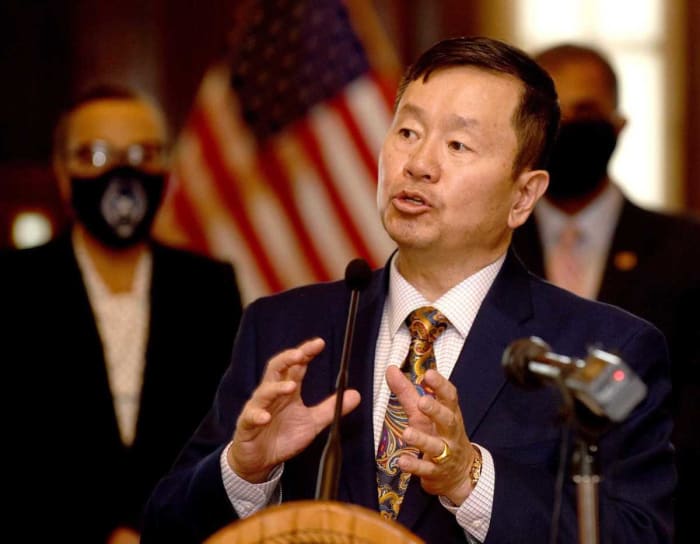
Choi (bottom) replaced Wolfe following his 2015 resignation (above), and has sought to avoid a repeat of the protests that led to his predecessor's ouster.
Don Shrubshell/Tribune/USA TODAY NETWORK
"I’ll be honest: I have disappointments about what I have seen since 2015,” says Douglas, the education professor. “I know that there have been individuals who have come [to Missouri] and have sought to do good work within the system. But I have not seen the system change.”
The flaws within that system go beyond any single leader. Like many schools, Missouri’s issues with race are deeply rooted in its history. The campus was built by enslaved people in the 1830s. Frederick Middlebush, Mizzou’s longest-tenured president (1935 to 1954), spent his career fighting to keep Black students out; he succeeded until 1950, when the school lost in court and a graduate student named Gus Ridgel broke the color barrier. Well into the 1960s, students were still waving Confederate flags and singing “Dixie” during football games. In response, the Alpha Phi Alpha fraternity established the Legion of Black Collegians, the nation’s first, and still only, Black student government. Alpha Phi Alpha was Anthony Sherrils’s frat.
Middlebush Hall today sits a 10-minute walk from the Black Culture Center, where a white student mockingly spread cotton balls in 2010. Across the street from Middlebush Hall stands the statue of Jefferson, unveiled in 2001 to honor his Louisiana Purchase, which included the land on which Mizzou sits. To many students, though, the sculpture embodies something else.
The current petition to have it removed, written by sophomore education major Roman Leapheart, focuses mainly on Sally Hemings, who, like all enslaved people, had no legal right to sexual consent. “I have several friends who have been sexually assaulted,” Leapheart says. “Walking by that statue, no one wants to see that and feel that every day. Nobody should have to see that.”
“It’s hurting more people than it’s benefiting,” says soccer player Eryka McIntyre. “More people are in pain versus people who are like, ‘Oh my gosh, yes! Thomas Jefferson!’ . . . For me, walking past that statue, I’m like, ‘That’s crazy. That’s a slave owner sitting here in my space.’ ”
Leapheart’s petition has received more than 3,500 signatures, about 2,500 more than a similar petition posted five years earlier by a member of CS1950. It might have gained more support if Choi hadn’t criticized administrators for signing it, and if (according to audio recordings leaked to the media) he hadn’t told another senior administrator to advise faculty against signing student petitions in general. Still, the cause has won broad support among the Tigers athletes who spoke to SI, many of whom had been reluctant to sign the petition for fear of reprisal.
Leapheart met with Choi on June 11, over Zoom, to share his views on the statue and to discuss its fate. The call, which included three members of the Legion of Black Collegians and three members of the MU system’s board of curators—the body that oversees Choi’s office—lasted less than an hour, by Leapheart’s estimate. “They [Choi and the curators] seemed to have their minds made up already,” Leapheart says. “I was explicitly told, by multiple curators, that they didn’t want the statue to go, and they were the only people who had a say in the matter.
“It felt to me like, Let’s listen. Let’s get multiple opinions, just to prove we did something.”
To members of CS1950, now approaching their 30s, that description sounds a lot like their talks with administrators five years ago. “They make you feel like you have a seat at the table, that you have a voice and your opinion matters,” says Ayanna Poole, a CS1950 member who teaches seventh grade in Texas. “They do it to save face.”
The day after the Zoom call, the university issued a statement in which Choi called his discussion with Leapheart “an example of the power of civil discourse” and added, “[T]he university decided not to remove the Jefferson statue. We learn from history. We contextualize historical figures with complex legacies. We don’t remove history.”
Choi moved quickly to squelch disagreement with his decision. After Sebastián Martinez Valdivia, an alumnus as well as a local public radio reporter and adjunct professor, expressed his disapproval with Choi’s decision over social media, Choi emailed him: “Shouldn’t there be some support for the institution that you serve[?]” Choi has also insisted on “investigations and sanctions” regarding vandalism of the sculpture. He presided over a Zoom presentation with administrators in July that was devoted almost entirely to the statue controversy, and in which he shared photos of cardboard signs placed at Jefferson’s feet (referencing his trading of enslaved people and his relations with Hemings), and a security photo of a white woman pouring a can of paint over Jefferson’s ponytailed head. Beneath that image, Choi wrote, “Offenders will feel ‘emboldened’ if no actions are taken,” and below that, in bold red type:
“Lost revenue from tuition and state support due to the aftermath of 2015 is over $200M for MU.”

McIntyre, a soccer player, has been one of several Mizzou athletes to speak out against the Jefferson statue on the quad.
Armond Feffer/Missourian
On July 7, Choi dismissed the dean of Missouri’s education school, Kathryn Chval, who was a vocal supporter of the 2015 protests and had signed the recent petition to remove the Jefferson statue. Choi offered little explanation for her removal other than that it was “in the best interests of the university” and that he had “lost faith in her leadership.” A vocal contingent of professors said it was reprisal. Days later, the university president doubled down on his suggestion that dissenters “look for another job,” telling the Columbia Tribune that if senior leaders don’t see things his way, “I think you should leave.”
Disagreement with Choi’s hard-line approach spread to the editorial pages of the St. Louis Post-Dispatch, which noted that “Choi owes his job to dissent” and called his dictates “purely Trumpian, a bit of authoritarianism making it clear that the boss’s word shall not be questioned.”
In a message relayed through Basi, Choi said he would “always welcome [faculty and staff] input” but reiterated his stance that those who disagree with the administration should leave, saying “This is similar to any employee at any company.”
(MU’s Division of Inclusion, Diversity and Equity, created in response to the events of ’15, hired a new leader, Maurice Gipson, the month after Choi decided to keep the statue in place. Gipson told SI, “I stand by our president.”)
During preseason football practice, SI’s requests to interview players about the various legacies of the ’15 protests, including the statue, were declined. But other athletes, as well as faculty members, have posed some version of the same question: Why has the university dug its heels in over a statue that’s younger than most of its students and has only a tangential connection to the university?
Pressed on that question during a July meeting of the Faculty Council, Choi cited potential “backlash” and the loss of “significant funding.” He did not respond to SI’s requests for clarification. His critics suspect that Choi is referring to the MU’s largely white base of donors—like those in the university’s Jefferson Club (minimum contribution for membership: $25,000), which commissioned the statue—and to state funding that must be approved by Missouri’s Republican governor and state legislature.
“It’s going to continue,” Alyssa Munlyn, a four-time volleyball All-America at Mizzou and a current graduate assistant, says of the fight to remove Jefferson’s likeness from the quad. “They can say no, but as long as they say no, they’re standing for something that isn’t right.”
Meanwhile, the university has installed a $66,000 security system behind Jefferson’s left shoulder. (Basi said this was part of a campus-wide security upgrade.) In late September, a $20,000 plexiglass case was constructed around Jefferson’s former gravestone nearby. “But who protects the psyche of a young Black woman, or any person of conscience, who walks past it?” asks Douglas, the associate professor. “What is it we value?”
McIntyre, the sophomore soccer player, sees a disconnect between the security spending and the university’s complaints of financial hardship. “It feels like they’re making a mockery of us,” she says.
“I’m tired of sitting here and being told to ‘just take it,’ ” says Leapheart, who has received all manner of online venom since posting his petition. “I’m tired of people who don’t experience the hate that I experience, saying . . . ‘Oh, that was 2015. Nothing’s wrong at Mizzou anymore.’ ”
***

In September, sprinter Suggs (center) led a march of Tigers athletes and their supporters.
Armond Feffer/Missourian
On Oct. 2, a group of students calling themselves MIZZOU 600—for the 600 people Jefferson owned—called for “600 hours of disruption,” and occupied Jesse Hall, in the heart of campus, shouting, “Whose campus? Our campus.”
It was nearly identical to the demonstration led by Jonathan Butler inside Jesse Hall five years earlier. Except that today there are rules in place—rules that allowed vice chancellor of student affairs Bill Stackman to arrive and inform protesters that they would be reported for discipline. Campus police asked protesters for their names.
It all sounds familiar to Simon and Sherrils. Simon, who went undrafted in ’16, five months before Colin Kaepernick first took a knee, and Sherrils, whose name went uncalled in ’18, don’t believe that their protest cost them their NFL careers. They do think, however, that they never got a fair shot. The starting safeties on that ’15 unit, which ranked ninth in the country in total defense and seventh in passing defense, point to their job interviews with league coaches, scouts and executives as evidence.
“The first questions they asked [were], What happened? Why did it happen? If something like that came up again, would [you] take a stance or speak out?” Simon recalls. “I answered that a billion times . . . and my answer was always the same. ‘If somebody needs my help and I can use my platform to help them, I am going to do that. I am going to do what is right.’ And I believe it affected my NFL career.”
Harris, the first-round pick of the Dolphins in ’17, says he was also “asked repeatedly” about his involvement in the protests before that year’s draft.
Simon, who spent a week with the Chargers in ’16, was working for Waste Management in Fort Worth that fall, collecting yard waste and recyclables, when he began getting calls from reporters asking about Kaepernick’s protest against racial injustice. “They asked, ‘What do you think is going to happen to him?’ I just told them what did happen to me. I said, ‘They’re not going to let him play. They’re not going to let him lead.’ ”
“Now [NFL gatekeepers] say, ‘We hear you. We understand,’ ” says Sherrils, “not really understanding the full effect of what I experienced. But if my sacrifice is going to allow another student-athlete to stand up, if my sacrifice can highlight the injustices we face, then I can live with it.”
Sherrils spent a couple of days with the Lions in their 2018 camp before being cut. Now a fitness trainer, his emotions get the better of him when he’s asked whether he would do it all again—whether he’d invite his teammates to the Black Culture Center, whether he’d tweet that photo and protest announcement to the world.
“Every time,” he says, voice quaking. “Every time.”
“As upperclassmen,” says Simon, “we knew we weren’t going to benefit from the protests directly. It was about who was going to come behind us.”
That torch has been picked up by athletes like sprinter Cason Suggs, who this summer founded the Mizzou Black Student Athlete Association, not as a replacement for the 2015 football players, Suggs says, but as “a space for Black student-athletes to share our experiences without being questioned or penalized.”
“There’s a standard here for us, as athletes, to be courageous in what we do,” says Keiarra Slack, a soccer midfielder and the MBSAA vice president. “We’re diving in head on and going straight to those in power, checking our coaches and checking our teammates.”
The racial climate on the ground at MU is improving, says Suggs, a junior from St. Louis. “There is a feeling of change,” he says, “this feeling of wanting to be educated. The coaches who know I’m leading this group, they come to me and say, ‘How do you feel about this? We want to have this conversation. Is this a good idea?’ Whether it’s a good idea or not, the fact that they want to talk makes me hopeful for the future.”
On a Wednesday night in September, Suggs and about 400 members and supporters of the BSAA met on the same quad where CS1950 pitched its tents five years earlier. They marched together to Faurot Field in a show of unity against racial injustice. These marchers—at least half of whom were white, everyone wearing a COVID-19 mask and black Mizzou gear—strode through campus chanting “We’re ready for change,” and holding handwritten signs with such messages as EVERY BLACK LIFE MATTERS, NOT JUST ON SEC SATURDAYS. A few coaches and athletic administrators took part in the march, including Drinkwitz, the new football coach, and men’s basketball coach Cuonzo Martin. Choi did not participate.
Meanwhile, on some of those other campuses where protesting football players followed the Missouri 2015 example, their stances have achieved results. Mississippi, for instance, replaced its state flag.
“I just wanted change to happen,” Simon says of the three days in November ’15 that upended his life and his alma mater. “We wanted a spark. We wanted something to get the ball rolling. I’d like to think that’s what’s happened.
“What we did, that was my way of leaving the university better than the way I found it. Whether anyone remembers the protests or remembers my name doesn’t matter. There were little seeds of change planted. There had to have been. Right?”

